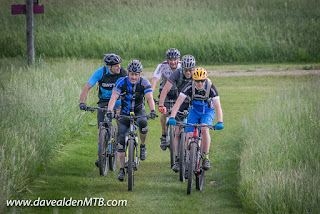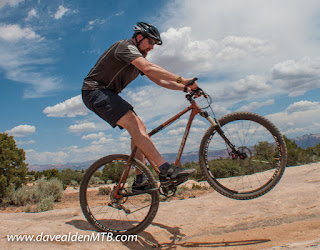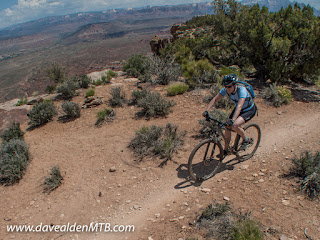I originally wrote this article about 15 years ago. Apparently it's been circulating on the Interwebs ever since because I recently got an email inquiry about it from a content developer in Australia. As I had a chance to review it, I realized that all of this still holds true today so I've dusted it off and made sure that it works with the latest iOS while also being ANT+ and Bluetooth compatible. Additionally, the tips below work with ALL hub spacing standards, all BB standards and all MTB wheel sizes, 26, 27.5, 27.5+, 29, 29+ although, if you want the fat bike tips, you'll need to send in $20 for the retrofit kit.
10 Tips to Better Mountain Biking
You want to ride like the wind. You want to be fast. You want to roll over rocks, shoot up hills and smoothly descend near vertical downhill sections. Maybe you want the fame, money and prestige that comes with being a pro cyclist.
Or maybe you just want to ride your local trails without crashing.
Well, no matter what your ultimate goals are, you have to start with the basics. And whether you mountain bike for fitness or just to enjoy the outdoors, having good bike handling skills and trail confidence will make it a much better experience.
We’ll get you started with these 10 Tips to Better Mountain Biking, and the rest is up to you…
1. Maintain your bike.
It is difficult to focus on the trail when you are listening to strange noises coming from your bike. Basic bike maintenance only takes a few minutes and it can save you from a long walk, or worse, a trip to the emergency room. Even if you can’t fix your bike, checking it will give you the chance to take it in to the shop before you hit the trail.
Go over the entire bike and look for anything that is worn out, cracked, broken or just not working right. Remember that minor problems at home can become big problems on the trail. Also, be sure that the bike is set up to fit you. A bike that is too big or too small will be hard to control.
2. Ride with better riders than yourself.
Not only will this help you to push yourself a little harder, but it will help you learn some of the riding habits of people who have been doing it longer. Watch how they position their bodies when going up or downhill. Watch how they handle rough rocky sections. And watch how they fix a flat tire miles from anywhere. These valuable skills can easily be picked up when riding with other riders. Check with local bike shops, or online to find group rides in your area.
3. Focus on where you want to go.
When you are on the trail, look where you want to go, especially on trails with plenty of roots and rocks. If you look at the rock or tree that you are trying to avoid, you will probably hit it. Instead, focus on the line that you want to take. This is called “target fixation.” There is a complicated explanation as to why this works, but don’t worry about that, it just does.
Always look ahead and find the line that you want, and you will be smoother.
4. Relax.
Whether you are riding a rigid bike or full suspension, the best suspension you have is your arms and legs. Stand up, relax and allow them to absorb the bumps and ruts on the trail. Once you learn to let the bike move beneath you, you will be able to float over most obstacles.
It also helps to relax your grip a bit on the handlebars. Be sure to hang on firmly, but not too tightly. A white-knuckle “death grip” will cause your forearms and hands to fatigue sooner and then make it tougher to be in control.
5. Spin.
Cadence, or the rotation of your cranks, is a very important aspect of cycling.
Professional cyclists spend a lot of time developing a good spin. If you pedal “in squares,” or with jerky downward strokes, you are actually throwing yourself off balance and working harder. Spinning is not only more efficient, but it help keep traction on loose trail conditions.
Good cadence incorporates pedaling “in circles” and being in the right gear. If you are geared too high, it will be difficult to power over things, and if you are geared too low you’ll spin out and jerk the bike around. But if you change gears to keep the same pedaling RPMs, around 70 to 100, you’ll find that it is much easier to climb and pedal through rough sections.
6. Learn the wheelies.
Wheelies and nose-wheelies (having the back wheel off the ground) are fun little tricks, and they are quite useful on the trail.
You can pull a little wheelie to get your front wheel up and over an object, and then shift to a nose- wheelie so your back wheel doesn’t hit. Even if you can’t get either wheel off of the ground, knowing how to take your weight off them will make some sections of trail smoother.
These are easier to do with clipless pedals, but less intimidating to learn with platform pedals.
Starting with one pedal up and one down, a basic wheelie is a combination of pulling up on the handlebars, shifting your weight over the back wheel and pushing down on the “up” pedal. You can just do it for the one half a pedal rotation, or try to maintain the wheelie and keep pedaling. Either way, keep your hand ready to pull the rear brake if you are going too far back. Grabbing the brake it will get your front wheel down.
The nose-wheelie is a little different. You definitely don’t want to do this if there is something in the trail that is going to stop your front wheel, and you don’t want to grab your front brake. Either one will toss you. In one motion, lean a little forward, push forward on the bars and pull up with your feet. Even if you are using platform pedals, you can hook your feet and still lift the back of the bike up.
7. Stop.
Hopping and balancing skills really pay off when riding very technical trails. Having the ability to come to a stop, and then start again, without putting a foot down, makes it easier to keep your momentum.
These are both done while standing still, though you can lunge with the bike while you are hopping to go up and over stuff (stairs, rocks, people, etc). Pure stationary balancing (also called a track stand) is done without holding on to the brakes. To learn this, practice going as slow as possible and feathering your brakes to cut your speed. It is easiest to learn this on a slight uphill slant. Soon you’ll be able to balance without going anywhere by shifting your weight and moving the bike beneath you.
Hopping is sort of the same concept, but done with both brakes locked and you pick up both wheels to keep the bike underneath you. With your body centered between the two wheels, compress your body, then push down to raise your body up, and then pull up with your arms and legs. It takes practice but it will soon become easy, and useful.
The little tricks may seem silly, but they do help to help develop overall bike handling skills.
8. Take a brake…
Actually take two brakes. Better braking will allow for better bike control. Many new riders think they only have two brake settings, locked, and not in use. You’ve actually got less control with the brakes locked, much like a car.
Learn how to use both brakes effectively. Most of your braking power comes from the front brake. But be careful not to use it too much if you are going downhill or cornering. You’ll either get tossed over the bars, or your front wheel will slide out, it is all about moderation and modulation.
When cornering, practice braking before the turn, rather than in the middle of it. You’ll soon be able to carry more speed through the turns.
When descending, learn to feather the brakes so that they don’t lock up. If they lock up, ease up a bit. You’ll not only have more control, but you’ll save the trail from excessive erosion.
9. Go yonder…
Once you’ve mastered your local trails, venture forth into the world and explore new ones. New trails and challenges will make it more exciting to be riding and they’ll help sharpen your skills. This is the key to becoming a well-rounded rider.
10. Ride everywhere.
The more time that you spend on your bike, the better you will get. Ride to the mailbox, to the store, to the coffee shop. This will help to reinforce your riding skills as you ride up and down curbs, dodge potholes and outpace angry chihuahuas. Once you can easily ride down two or three stairs, you can approach trail obstacles with a little more confidence.
You can read about cycling as much as you want, but nothing replaces saddle time. So with that in mind, put this down, gear up and get out and ride. I’ll see you on the trail.








No comments:
Post a Comment